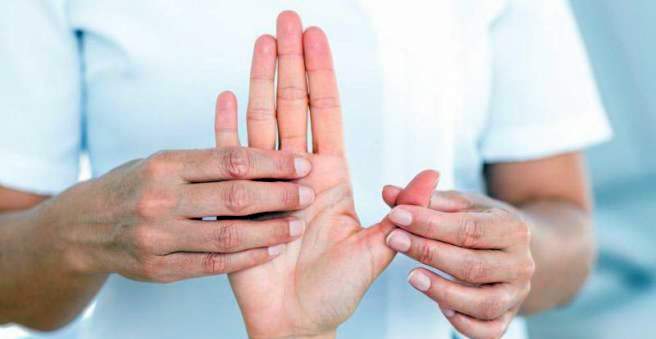The Dupuytren contracture (also Dupuytren’s disease, Dupuytren’s contracture, Dupuytren’s disease) is a disease of the tendons of the hand. By shortening the tendon structures in the palm of the hand, patients lose the ability to stretch their fingers. An operation can improve the symptoms. Often, however, the symptoms reappear after a period of time. Read all about the symptoms and treatment of Dupuytren contracture here!

Dupuytren Contracture: Description
The Dupuytren contracture is a disease of the hand tendons, which was named after Guillaume Dupuytren. The French doctor first reported his illness to the students in 1831. Dupuytren’s contracture affects mostly men over the age of 50 years. In women, the disease is generally milder and occurs only at a higher age. Northern Europeans are more likely to develop Dupuytren’s disease than people of other races.
The word contracture comes from the Latin “contrahere”, which means “to contract”. It describes in medicine the shortening or shrinkage of structures such as muscles or tendons. This change restricts mobility in the joints.
The Dupuytren contracture describes a disease on the hands. Similar diseases also occur on the foot or on the penis. They are then called Ledderhose’s disease (on the foot) or Induratio penis plastica (on the penis).
Dupuytren contracture: symptoms
As a rule, Dupuytren’s disease is painless. The patients first notice ring-shaped indurations on the ring finger and little finger. Over time, the flexor tendons of the affected fingers shorten. As a result, the fingers are fixed in the flexion position. Patients can stretch their fingers increasingly badly. In addition, the palmar fascia (palmar aponeurosis) scars, allowing patients to palpate small nodules on the palm of the hand.
The Dupuytren contracture often affects both hands. The expression of the contractures on the hands can be different.
Dupuytren contracture: causes and risk factors
The exact cause of the Dupuytren contracture is not yet known. It is believed that genetic influences play a role in the formation. The course of the disease is also likely to be influenced by genetic information. For example, Dupuytren’s disease is significantly faster and more severe in some people than in others.
Apart from the genetic component, other diseases also play a role in the development and course of Dupuytren’s contracture. Many patients also suffer from diabetes mellitus. But also alcohol abuse or seizure disorders (epilepsy) are diseases, with which the Dupuytren contracture is more often associated.
Dupuytren contracture: examinations and diagnosis
If you feel tensions in the palm of your hand and have difficulty moving, especially when stretching your fingers, consult a specialist in orthopedics. In the case of suspected Dupuytren’s disease, he first asks you in detail about your medical history (anamnesis). He will ask you the following questions:
- Do you have and restrictions on moving your hands?
- Since when do the complaints exist?
- Are both hands affected by the discomfort?
- Does a blood relative suffer from or suffer from Dupuytren’s disease?
Subsequently, your doctor will examine you physically. He looks at your hands to determine possible skin retractions. He then scans the palm of your hand to sense nodular changes or indurations on the palm or along the sides of the fingers. He then moves your fingers one at a time to assess the strength of the movement restrictions.
Dupuytren contracture: staging
Dupuytren’s contracture is divided into various stages. A common classification is that of Tubiana. The strengths of the contractures of all fingers are recorded and classified as follows:
- Stage 0: no complaints
- Stage 1: Contractures between 0 and 45 °
- Stage 2: Contractures between 45 and 90 °
- Stage 3: Contractures between 90 and 135 °
- Stage 4: Contractures over 135 °
Dupuytren contracture: Similar diseases
Of a possible Dupuytren’s disease, the doctor must differentiate other diseases. These include:
- Callus (new formation of bone substance, for example after a break)
- Cysts (fluid-filled cavities)
- Rheumatoid arthritis (“rheumatoid arthritis”)
- so-called intrinsic contractures (originating from the joint or the artificial skin, not from the tendons or muscles)
- Overlaws in the palm of the hand (palmar ganglia)
- Tendonitis (tendosynovitis)
- Tumor (tumor)
Dupuytren contracture: treatment
The treatment of choice is the Dupuytren’s disease surgery. However, it should not be done too early in the disease process. Dupuytren surgery is recommended if the patient can no longer lay the affected hand flat on the table. This is usually achieved in stages 1 to 2, ie with contractures over 30 °.
A conservative treatment, ie the non-operative Dupuytren’s disease therapy, achieved no demonstrable success in the Dupuytren contracture. The sole benefit of massages or physiotherapy is that the progression of the disease can not be stopped.
Dupuytren contracture: surgery
In Dupuytren’s operation, the shortened aponeurosis of the palm is zigzag split. This technique makes it possible that little or no scarring will result from the surgery. The goal of the surgery is to remove the entire shortened tissue.
Main objective of the operation, the restoration of the mobility of the hand and not the cure of the disease. As a side effect of the surgery can damage the blood vessels and nerves occur.
After the operation, the hand is immobilized by a forearm plaster splint for about five days. After about two weeks, the threads can be pulled. It is important to begin rehabilitation after the procedure, such as physiotherapy, to ensure the mobility of the hand. Some patients develop Sudeck’s disease, a type of nutritional disorder of the hand.
Dupuytren contracture: disease course and prognosis
The Dupuytren contracture varies in different patients. As a rule, the disease begins with a hardening of the palm. This can persist for months to years without further changes. This is followed mostly by skin retractions and finger stretching problems.
In some patients, Dupuytren’s contracture is significantly faster than others. Even after successful surgical therapy, the Dupuytren’s contracture reappear after years.